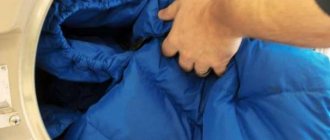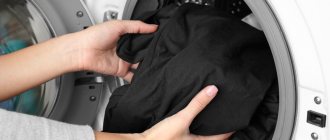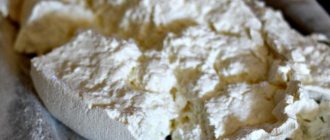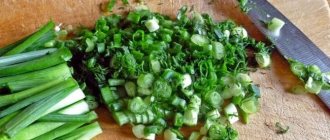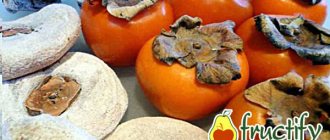09/11/201602/14/2017 Maria Ivanova 2 comments
With the arrival of a child, the house is filled with joy and trepidation. Parents will have so many joyful moments; new discoveries and achievements await them. But before moving on to these joys of learning new things, new parents face many challenges. They should get used to a new routine and new worries.
One of these concerns is, of course, laundry. With this word, a lot of questions arise in the expectant mother’s head: what to wash, at what temperature, how to treat baby diapers, what products are better? And we will try to answer them.
General information
Many expectant mothers, being in an interesting situation, put off buying everything they need until the birth of the child. This is usually associated with various superstitions.
This approach is not very practical. After all, it’s not enough just to buy tiny diapers and vests; before the baby is born, they also need to be washed and ironed. And this is done for a number of reasons.
First of all, purchased items may contain starch (it is added to products to add shine), the use of which is extremely undesirable for children's items. In addition, the fabric went through several hands before it was formed into a cute onesie or romper. Then it was with the seller, the packer and who knows who else.
There is only one conclusion - it is imperative to wash a newborn’s clothes. In principle, all new things need to be washed, but when it comes to children’s clothes, there can be no deviations from this rule at all.
In the first weeks and months, a child’s skin is especially sensitive to external influences, and it is extremely important to avoid the occurrence of allergic reactions during this period. Of course, this reaction does not occur in all newborns, but it is better to be safe.
It is worth remembering that for the first contact with the baby’s skin, new things only made from natural fabrics are suitable. The detergent must also be special, but we will talk about this later.
You should prepare for the fact that there will be quite a lot of laundry and perhaps buy a little more clothes to prepare a supply.
After washing, all purchased clothes must be ironed on both sides. And this is not just a tribute to tradition - double-sided ironing (preferably with a steamer) will help kill all possible microbes.
Washing nappies and nappies
The first few days, while the newborn’s umbilical wound has not yet completely healed, all linen - diapers, diapers, and undershirts - should not only be washed, but also boiled and ironed! When the wound heals, one starka and a thorough rinse will be enough so that the soap residue does not irritate the skin. Boiling and ironing may only be necessary if the child has skin problems: diaper rash, eczema, etc.
Before washing diapers, rinse them in cold water.
Dirty diapers and diapers should first be washed under a strong stream of water and only then soaked with other diapers.
Soak dirty diapers in water and baking soda. This will not only make washing easier. but it will also take the smell away.
After soaking the diapers and diapers, wring them out, change the water and put them to boil. Add non-alkaline soap to the water: baby soap, lanolin soap. glycerin
Soap for boiling is grated on a coarse grater and stored in a closed jar.
Until your baby is three months old, refrain from using washing powders. If a child has exudative diathesis, it is better not to use powders at all.
During the final rinse, also add baking soda to the water. This will make the diapers softer. Soda is a natural water softener and. Unlike advertised products, it does not cause skin irritation in children.
If you use washing powder, you need to rinse the diapers at least 3 times in plenty of water.
If the diapers need to be boiled, you can replace it with a simpler procedure. Lather the diapers and dip them in a basin with a weak solution of potassium permanganate for a few seconds. The water will instantly become cloudy and dirty. and the diapers will be disinfected.
To whiten diapers, you can use a weak solution of vinegar.
Vinegar can also be used to soak laundry.
For the first 2-4 weeks, it is advisable to iron both diapers and nappies with a hot iron on both sides. This must be done in the future if the child has skin problems.
From washing powders, choose special ones for children. They contain fewer substances that irritate the skin. But even if you use special children's washing powders, be sure to rinse the laundry thoroughly.
Getting ready to wash
Even before washing new clothes, the expectant mother should take care of a number of issues.
First of all, you need to purchase a separate laundry basket for storing newborn clothes.
It is recommended to wash children's clothes separately from adults for at least the first six months after the baby is born, and preferably a year. The same goes for storage. The thing is that an adult’s body may have “its own” bacteria for which the child’s body is simply not ready yet.
Mom's clothes, in which she nurses a newborn, should also be washed separately from other clothes.
Before washing, all items must be sorted by color and texture of fabric.
Remember to ensure that there are no traces of food or feces left on clothes being washed. It is recommended to pre-wash such items using running water and baby or laundry soap.
We also remember the main rule of washing - it’s easier to wipe off any stain immediately after it forms. Therefore, we do not accumulate large piles of laundry and do not allow stains to become stronger on the fabric.
There are quite a few rules for washing baby clothes. At first, young parents may feel dizzy. At the same time, children's things are subject to contamination more often than usual. Therefore, the requirements for washing powders must be very high.
How to properly handle things before the birth of a baby?
Many people are interested in how to wash children’s clothes in the maternity hospital, and if you are also asking this question, now you can get the answer. After purchasing new items, be sure to wash them in order to remove starch and other substances harmful to the skin of a newborn, which are located deep in the fibers of the purchased clothing. Is it possible to wash baby clothes in a machine before sending them to the hospital? It is possible, but several important conditions must be met:
- Set the correct temperature. At what temperature to wash clothes for newborns it was already said earlier, you can also check the label of the clothes - there are exact recommendations for washing.
- Use special baby soap for washing - it not only cleans clothes well, but also does not harm the delicate and sensitive skin of a newborn baby. Washing powder cannot be used.
- After washing, be sure to iron the clothes on both sides with steam treatment - this removes germs.
Thanks to the guide, you know well whether diapers can be washed in a washing machine, how to do it correctly, and also how to wash diapers for newborns. Such seemingly trivial knowledge is very important for the baby’s health, as well as for the safety of the things themselves. Never miss an opportunity to use them!
How to wash children's clothes?
Nowadays, a huge variety of detergents for washing children's clothes are sold. However, the question of how to wash newborn clothes is more relevant than ever.
Many mothers, trying to avoid allergies, wash all their newborn's clothes by hand using laundry soap. This approach has its place, because ordinary soap has a number of advantages.
- Good soap contains minimal harmful chemicals. Preference should be given to baby soap, preferably unscented or with a light herbal aroma. This will mean that the composition contains no fragrances or fragrances.
- A rare product can compete with soap in terms of caring for things. The natural composition of the soap contributes to its gentle attitude towards things.
- Another argument in favor may be the fact that things washed with baby soap are especially soft. Few powders will help achieve this effect. For this reason, fabric softener was invented.
Still, not all mothers are ready to wash, the old fashioned way, with soap. This is where modern laundry detergents come to the rescue.
Selecting a product that meets all your requirements from the huge selection of products presented will not be difficult. There are several aspects to remember.
- Always carefully study the composition of the powder or liquid detergent before purchasing. The content of chlorine, surfactants and various phosphates is not allowed. The best option would be a powder based on soap shavings.
- It is better that the packaging bears the inscription “hypoallergenic”, as well as a note indicating at what age the product can be used. For the first months of life, we are looking for a product with the “0+” icon.
- The selected product should dissolve quickly in water and be easily washed out of the fabric. Therefore, you should not buy a large package of powder at once. It is correct to take a small pack for testing. At the same time, you can check if your child is allergic to this product.
- In addition to the composition, you should study the standards and storage conditions of the powder. Don't neglect them.
- Also, don’t forget about the expiration date. Washing with expired powder for baby clothes is unacceptable.
- Do not experiment with the dose of laundry detergent. You should not sprinkle the powder “by eye” in an attempt to better wash children’s costumes in order to avoid itching and other signs of allergies in the baby. Follow the instructions on the package.
What soap to use for a newborn
The main criterion when choosing any cosmetic product for a newborn is the safety of the product.
Start with neutral antibacterial liquid soap or cream soap made on a natural basis without allergenic additives. Glycerin is safe for babies, as glycerin gently moisturizes the skin, protects from the negative effects of heat and cold, and from dryness and flaking. As a result, the baby's skin becomes soft and protected. To determine what soap to wash a newborn with, you need to consider the types of product. Today, manufacturers offer the following types of soap:
Liquid soap has a balanced composition and is perfect for babies in the first months of life. This product does not dry the skin, does not cause irritation, acts very softly and delicately, so it will not harm the baby’s skin. Liquid soap can be used every day without harm to the child; Cream soap contains glycerin and lanolin. These are safe components that soften the skin, relieve inflammation and effectively resist bacteria. Cream soap is perfect for bathing your baby. But sometimes it may contain fragrances and fragrances, so check the composition carefully before purchasing; Solid soap dries the skin, but at the same time creates a dense protective layer. This remedy is chosen for a child older than a month and is used no more than once a week. In addition, baby solid soap is perfect for washing hands during the day, as well as for washing baby’s clothes and bedding. This product creates a strong, durable foam.
It has a more gentle composition and is more adapted for children's skin; it is less likely to cause an allergic reaction in infants than children's washing powders; Soap with various additives, such as chamomile, sage, fir, plantain and other natural extracts, should be used with caution. Some components, especially aloe, citrus and pine needles, can cause allergies in a child
However, if the baby does not have a negative reaction, such remedies will be very useful. They soothe, heal wounds and relieve itching, reduce swelling, sweating and diaper rash.
Before purchasing, carefully study the composition of the product. It is better to use soap with additives after two to three months, when the baby’s skin is more adaptable to new conditions. The safest are chamomile and string, calendula, celandine, eucalyptus and sage. Products with the addition of pine needles or honey are used for children older than 5-6 months. And it’s better to avoid citrus soap altogether.
You can’t wash your baby or wash baby clothes with laundry soap! The high alkali content in this product greatly irritates the skin. As a result, the child becomes allergic to laundry soap. But it is perfect for washing and disinfecting a baby’s bathtub. Read here how to properly wash a bathtub for a newborn.
Do we wash by machine or by hand?
Another question that causes quite heated discussions is how best to wash children's clothes - manually or in an automatic machine. Let's consider each option separately.
Of course, hand washing has the advantage of being more hygienic. A separate basin is used for hand washing children's underwear, which means that the newborn's things do not come into contact with adult clothing.
But that’s probably where the advantages end. They are being replaced by a number of disadvantages that should be taken into account when choosing a washing option.
- When washing by hand, it is impossible to rinse things as well as when washing by machine. This means that in order to remove cleaning products from the fabric, you will have to rinse more times.
- Spin. Competing with a washing machine in this matter is also not easy. If things are washed in the summer, minutes may seem insignificant, because in the sun everything dries in a matter of hours. But what about in the cold season, when the sun does not pamper us with its presence and the laundry dries in the room for a day, or even two?
- Hand washing is possible only at a temperature of 30-40 degrees, no more. Otherwise, you risk damaging the skin of your hands (even when using gloves). For half of the stains, water at this temperature will be useless and it will not be possible to remove the stains. This means you will need boiling.
Needless to say, pediatricians prefer hand washing using baby soap. Of course, it’s always much easier said than done. But what about a young mother who doesn’t have an extra hour, not only for laundry, but even for sleep?
The answer is obvious: use the washing machine, following our recommendations.
Brown laundry soap
For many years in a row, despite the variety of washing powders, many women prefer ordinary laundry soap. Due to the fact that it contains no substances that irritate the delicate skin of babies, its use completely eliminates the occurrence of allergies and allows you to solve the problem of how to whiten baby diapers. There are two ways to remove stains with soap:
- Fill a basin with hot water, soak things in it, and then rub them with soap. After 30-40 minutes, you will need to first wash them and then rinse them 2-3 times. The correct result is no stains and clean water after the last rinse.
- The second method is to use machine washable soap. It is necessary to grate half the block and pour 100 ml of water into the resulting shavings for 15-20 minutes. Next, you need to pour the mixture into the powder compartment, place dirty clothes and diapers in the drum and select the desired mode.
We suggest you familiarize yourself with How to bleach old and yellowed tulle at home: 7 ways
Rules for washing in a washing machine
If you decide to use a washing machine for washing, there are a few rules to remember.
- Separate wash. As mentioned earlier, you should not mix baby diapers with the clothes of the whole family. Therefore, before putting laundry into the drum, make sure that no foreign objects have fallen into it.
- Avoid heavily soiled items. During the first months of your child's life, avoid washing heavily soiled items in the drum. An example of such contamination could be work overalls or dirty shoes.
- Temperature. It is recommended to wash newborn clothes at a temperature of 60-70 degrees. If your machine has a “baby wash” mode, feel free to use it.
- Powder selection. When choosing a machine wash, you should not use plain soap, even grated soap. This may damage the washing machine. It is better to use special means.
- Moderate amount of things. Do not fill the washing machine drum to capacity. For best washing, it should be two-thirds full. This will allow water and detergent to circulate smoothly in the machine.
- Labels on clothes. Carefully read the information on clothing labels and adhere to the instructions indicated there.
- Air conditioner. It is better to avoid using air conditioning in the first months of your baby’s life. When you do use it, make sure that the product does not have a strong odor and contains information on the packaging that it is suitable for children's underwear.
How are things going with ironing - is it possible and how to iron correctly?
If we have already dealt with the questions about at what temperature to wash diapers for newborns, and on what mode to wash things for a newborn, then the topic of ironing is still shrouded in mystery. The main rule that needs to be understood is that before the baby is 4 weeks old, things must be ironed on both sides in order to completely kill harmful microorganisms - they can enter the baby’s body through the umbilical wound. It is also very important to steam your clothes while ironing, so as not to give bacteria and germs any chance to live.
If your washing machine has a steam cleaning program, you can use it - it can effectively process washed items from all sides, making them safe for the health of the newborn. When the child’s umbilical wound heals, the issue of ironing can no longer be approached so seriously - it’s enough to iron some things, and completely trust the rest to the washing machine, leaving free time for yourself.
How to get rid of stains?
When washing children's clothes, there may be cases when machine washing is not enough.
Sometimes the machine is unable to remove traces of fruit puree or other stains on the clothes of newborns. As we have already said, the use of bleach, as well as any products containing chlorine, soda and phosphates, is unacceptable. In such cases, hydrogen peroxide will come to the rescue. Due to its composition, it is harmless to children's skin and will not cause allergies. It easily removes most of the dirt and is easily washed out of the fabric.
Bleaching things
If you need to remove marks from greasy food or other stains, you can use stain removers for flannel. But choose brands without chlorine, especially for woolen fabric.
For undyed types of flannel items, bleaching with ready-made compounds without aggressive additives is practiced. The most harmful is chlorine, which thins the fibers.
The gel from the Persil Universal line brightens well. Its use is practiced for manual and machine cleaning of products.
Home whitening techniques are popular. For undyed cotton items, use baking soda - 2 tbsp. l. Dissolve it in water - 6 liters, heated to 20˚C. Before washing, soak the items for two hours.
How to bleach flannel correctly
If yellow marks appear on the surface of flannel products, take ammonia with a liquid composition used for dishes. These components are measured in 50 ml. Combine with water warmed to 20 degrees - 250 ml and add baking soda - 3 tbsp. l. Stirring, bring the liquid until smooth. Spray with a spray bottle onto contaminated areas. After 10 minutes, wash by hand.
We wash diapers
Baby diapers deserve special attention, or rather, the issue of caring for them.
First of all, you should not wash the described diapers every time. Baby urine is practically colorless and odorless, so you can get by with rinsing a couple of times.
Naturally, this rule does not apply to traces of feces. Such stains should first be washed off with water and washed with soap. Afterwards, wash in the washing machine on the “boiling” mode or at a temperature of 90 degrees. This type of washing will keep your clothes clean and free of bacteria.
How to sew diapers for a newborn: a guide for mothers
Diapers are an invariable part of a newborn’s “dowry”. Even now, when mothers use diapers to their fullest extent, and resort to swaddling less and less, a supply of diapers in the house will not be superfluous.
It is very easy to sew diapers yourself. For those who, like me, decide to do this, the instructions are below. I tried to cover all the questions: the number of diapers, cotton and flannel diapers - how many of them, the size of the diapers, cutting (a convenient tip that I used to sew them myself), finishing the edges.
Where can diapers be used other than for direct swaddling?
- You can put them on the changing table when changing your baby (changing a diaper).
- Use to put it in the stroller while walking.
- Place it on your shoulder before picking up the baby (clothes are not always clean).
- Take it with you to your doctor’s appointment (although some people prefer to use disposable diapers in this case).
- Cover the child during sleep when it gets hot under the blanket.
Different mothers need different numbers of diapers. It all depends on the chosen “system” - on whether you are going to swaddle the baby or not. Sometimes mothers even have to change their plans a little.
For example, you did not intend to swaddle the baby, but the baby twitches his arms in his sleep and wakes up from his own movements - in this case, you can loosely swaddle the baby while he sleeps. Some people prefer to leave the arms free and swaddle up to the waist. In general, there are different options.
And you can choose your own only when the baby has already appeared in your house.
To begin with, you can acquire a conditional minimum. Let's say a dozen diapers should be enough for the first time. To be on the safe side, you can buy a pack of disposable diapers (disposable diapers are on the list of things that you will take with you to the maternity hospital; maybe you will still have them).
According to preliminary calculations, you can get 10-15 diapers. Although some mothers who use diapers, according to reviews, 5-6 are enough. I sewed 9 for my spring baby: 6 calico and 3 flannel (even though I used reusable cloth diapers).
Now about what kind of diapers these should be. Diapers can be thin or thick (depending on what material they are made of; most often - from chintz and flannel). If you are expecting a baby in the fall or winter, then you may want to have more flannel ones in your arsenal than chintz ones.
The size of standard store diapers is 80*110. But since we are going to sew the diapers ourselves, we have cards in our hands - we can choose any “dimensions”. Any, but not quite. In terms of “width” we will have one strict limitation - the width of the panel of the source material. But in terms of “length” we are not limited by anything.
Experience shows that it is more convenient to use diapers larger than 90*90. Firstly, the baby is growing quickly. Secondly, large enough diapers can then be used instead of a sheet in the baby’s crib.
For example, diaper sizes of 80*125 cm, 80*130 cm may be convenient (the first parameter is the width of the material).
We suggest you read: Is it possible to wash bamboo pillows in a washing machine?
Diapers are a must-have item on the maternity hospital list. And it’s no coincidence. This is a multifunctional product that can be used as clothing, hygiene product or bedding.
Five pluses
Why is it profitable to sew diapers yourself? Experienced parents cite five reasons in favor of “hand-made diapers”.
- Connection with the baby. Both during pregnancy and in the first weeks after the birth of the baby, a woman radiates a special mood and experiences a powerful feeling of happiness. By creating things for the child in this state, the mother, as it were, “charges” them with her love and warmth.
- Coloring to taste. When sewing yourself, you are not limited by the range of children's stores. You can take any fabric you like or even combine several. Yes, at least use your grandmother’s robe for diapers if you like flowers a la the 60s. At the same time, the baby will be a real fashionista, because you won’t find such diapers in the store.
- "Healthy" texture. When the mother chooses the fabric herself, there is no doubt about the naturalness of the product and its environmental friendliness.
- Custom size. Here you don’t have to rely on the standard size of baby diapers. The main thing is not the template, but that they are sewn according to the baby. Then the baby is more comfortable, and it is easier for the mother to learn the correct methods of swaddling.
- Saving the family budget. You don't have to spend any money at all. Just take a good look at the shelves in your closet. Surely there will also be Soviet-era sheets or father’s flannel shirts. All this, with a flick of the hand, turns into good-quality, and most importantly free, diapers for a newborn.
Making a diaper begins with choosing fabric. The golden rule is that, regardless of density, it must be 100 percent natural.
Another recommendation from experienced parents: do not use materials that are too bright or acidic in color. Firstly, such paints can have an irritating effect on a child with a fragile psyche.
Secondly, the drawing is likely to fade, leaving marks on the child’s body.
It is important to take into account the texture of the material. It is a misconception that “summer” children need only light sheets, while those born in winter will need only warm fabrics. Regardless of the time of year, babies need both thick and “airy” diapers.
There are four types of fabric that are most suitable for sewing diapers.
- Tale. Purely “winter” fabric. It is very dense, the pile is located on both sides. Even outerwear is made from woolen yarn. And wool-blend flannelette diapers are the best assistant when caring for a child in low-temperature conditions.
- Flannel. Due to the similarity of characteristics, it is often confused with a bike. It is also a cotton fabric, but generally less taut. Most often, there is lint on only one side. It is characterized by softness and high heat transfer.
- Chintz. "Summer" option. Cotton material that allows the body to breathe. In hot weather, cotton clothing saves you from overheating.
- Knitwear. A good cotton demi-season option. Diapers made from this fabric instantly take on the baby's shape. Knitted products are soft, relatively light, and at the same time can quickly warm you up.
Size
Having chosen the fabric, decide on the size of the product. It should not be tiny, it is better if there is a certain reserve of centimeters “for growth”. Correct calculation of the width and length will allow you to use the diaper from birth until at least six months.
As such, there is no standard size of diapers for newborns. Everything here is individual. To understand which pattern to use as a basis, the age, weight and height of the child are taken into account. The table below shows a basic calculation of the product parameters and indicates what size diapers for a newborn should be, depending on his individual characteristics.
Age, months Weight, gHeight, cmSize, cm
| 3200 | 50 | 85x90 | |
| 1 | 4000 | 54 | 90x100 |
| 1,5 | 4400 | 56 | 110x110 |
| 2 | 5000 | 58 | 120x120 |
| 3 | 5700 | 61 | 120x150 |
If the parents’ finances allow them to buy new fabric rather than remake old bedding or clothing, then several nuances need to be taken into account. The choice of material also depends on what size diapers for a newborn should be.
For example, for sheets 90x100 you will need a fabric whose width does not exceed 95 cm. A light margin in this case is even necessary, since hebesh fabrics often shrink after washing. But taking one and a half meter pieces for medium-sized products is short-sighted.
In this case, you will have to trim the edge, which means more work, and the fabric will be wasted.
But for a product 120×150, a width of 150 cm is very suitable. But such a canvas costs a little more. Yes, and larger diapers require more fabric. For example, for five medium-sized products you will need 4.5 m.
The same number of dimensional diapers can be sewn from six meters. But the crumbs grow quickly, so even if you can save on size at first, the quantity will still end up tripping you up.
Quantity
Before you start cutting fabric, you need to understand what kind and how many diapers a newborn needs. Everything here is also individual. It is recommended to “dance” depending on how the products will be used.
If they are needed only for swaddling while sleeping, then it will be enough to have three to five cotton ones and the same number of flannel ones.
When parents refuse to use diapers, then approximately the following supply of diapers is needed: about 20 cotton and 20 flannelette. And if there are water shortages in the house or limited space for drying clothes, you may need even more.
The most interesting thing is that almost any mother and even father can prepare such canvases for a baby with their own hands. No tailor experience required here. You can even do without a sewing machine. In addition, you can experiment. For example, decorate the product with a tied bow or sew Velcro in the place of intended fixation. What do we have to do?
- Wash. Before you begin, be sure to wash the fabric in water at 60 degrees. This will avoid changing the size of the finished product if the material shrinks.
- Open it up. After washing, the fabric is ironed and laid out on a flat surface. Using a centimeter we make markings. Marks can be left with soap or a simple pencil. Afterwards we cut it.
- Overcasting. If the fabric was bought in a store and was chosen to fit, then the side edges will not need attention: they are processed at the factory. You will need to sheathe the top and bottom. If you have a machine or an overlocker, that’s great. Simple and zigzag stitches are suitable. If there are no such tools, we use a needle and thread. Here you need a basic overlock stitch, which is well known from school labor lessons. If the blanks were cut from old things, you will need to put all four sides of the diaper in order. It is not recommended to overcast by folding the fabric. Edges can give, especially if we are talking about thick fabric.

